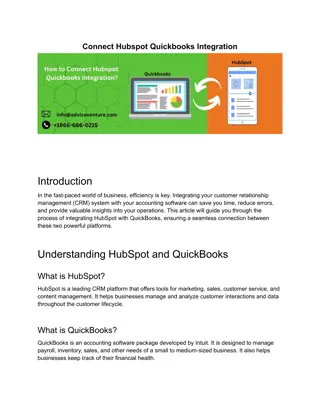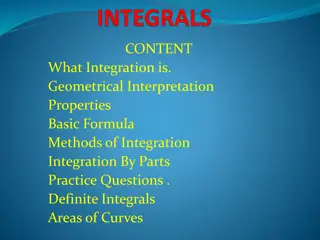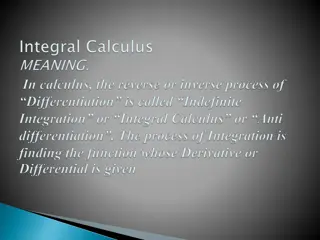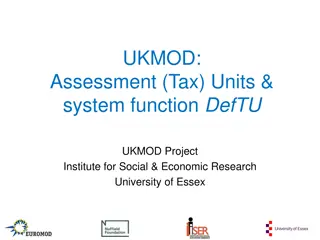Integration of HBAI and FRS Data for UKMOD Analysis
This study examines the integration of HBAI (Households Below Average Income) and FRS (Family Resources Survey) data within the UKMOD framework. It explores the differences between these datasets, their application in analyzing equivalised disposable household incomes, and the methodology used to incorporate HBAI variables into the analysis. The research aims to enhance understanding of income distribution and provide insights for policymakers and researchers.
Download Presentation

Please find below an Image/Link to download the presentation.
The content on the website is provided AS IS for your information and personal use only. It may not be sold, licensed, or shared on other websites without obtaining consent from the author.If you encounter any issues during the download, it is possible that the publisher has removed the file from their server.
You are allowed to download the files provided on this website for personal or commercial use, subject to the condition that they are used lawfully. All files are the property of their respective owners.
The content on the website is provided AS IS for your information and personal use only. It may not be sold, licensed, or shared on other websites without obtaining consent from the author.
E N D
Presentation Transcript
HBAI data in UKMOD Matteo Richiardi, Daria Popova and Justin van de Ven University of Essex UKMOD Fest Oct 2024, University of Essex
Overview FRS and HBAI Choosing between HBAI and FRS data Integration of HBAI data Comparative statistics 2
FRS and HBAI Family Resources Survey (FRS) Data available from 1993/94 Administered by DWP Finer detail concerning income sources than most other UK studies Substantial sample size (approx. 3 times the LCF) LCF income top-coded from 2006 Default data source for UKMOD Packaged for UKMOD from 2003/04, 2008/9, 2009/10, 2012/13+ Households Below Average Income (HBAI) data HBAI based on the FRS (from 1996) Adjustments to survey weights and income definitions for high income households evaluated using data from the Survey of Personal Incomes (SPI, administrative HMRC) Slight differences in sample 3
FRS and HBAI Gini of disposable household equivalised income (BHC) 40 39 38 37 36 35 34 33 32 31 30 1990 1995 2000 2005 2010 2015 2020 2025 HBAI Table 1.2 ONS: The Effects of Taxes and Benefits on Household Income, UK, 2021/22, Table 6a FRS (UKMOD default input from 2012) 4
Choosing between HBAI and FRS data General rule is to use HBAI data if focus is on equivalised disposable household incomes, especially for distributional analyses HBAI data is the basis for the DWP s HBAI publication Considered more appropriate for identifying distributional metrics for equivalised disposable income than FRS Complications with respect to UKMOD HBAI focus is disposable income Measures of original (private) income are imputed in HBAI used as input to UKMOD Slight differences in variable definitions (complicating comparisons) HBAI has slightly smaller sample size 5
How have HBAI data been integrated? New variables from HBAI integrated into input data sets: 2018(a4), 2019(a2), 2020(a2), 2021(a1, b1), 2022(a1,b1) A new policy over-writes FRS variables with HBAI variables The new policy is activated via a new model switch 6
Variable mapping from HBAI to FRS hbai_ypt_ind hbai_yiy_ind yptot, yptmp (private transfers) yiy, yiynt, yiytx, yittx, ydvtx (investment inc) + ypr, yprnt, yprtx (property inc) hbai_gs_pp hbai_ypp_ind hbai_yot_ind hbai_yem_ind hbai_yse_ind hbai_yds_ind dwt ypp yot01 (other) yem (employee) yse (self-emp) yds (disp inc) (weight) (pension) 7
The UseHBAI_uk policy Over-writes default model inputs reported by the FRS with values reported by HBAI 8
HBAI vs FRS: earnings (2021) Ratios of earnings of UKMOD by data source to ASHE ASHE 2584.4 3049.8 2120.3 UKMOD (HBAI) UKMOD (FRS) 1.12 1.15 1.06 all male female 1.06 1.06 1.04 15
HBAI vs FRS: earnings (2021) 100 90 cumulative % of earners 80 70 60 50 40 30 20 10 0 0 1000 2000 3000 4000 5000 6000 7000 Earnings per month ASHE - male ASHE - all ASHE - female 16
HBAI vs FRS: exogenous expenditure (2021) case loads FRS 0.96 0.91 0.99 1.89 0.65 0.69 0.62 1.04 0.59 0.29 0.61 0.99 expenditure FRS 0.51 0.90 1.09 2.36 0.63 0.67 0.54 1.01 0.57 0.29 0.43 0.94 HBAI 0.98 0.91 0.99 1.84 0.64 0.67 0.77 1.01 0.54 0.24 0.59 0.96 HBAI 0.53 0.90 1.07 2.32 0.62 0.65 0.72 0.98 0.54 0.25 0.41 0.91 Contributory ESA new/basic State Pension Second State Pension Bereavement Benefits Attendance Allowance Disability Living Allowance Severe Disablement Allowance Carer's Allowance Industrial Injuries Disablement Allow. Maternity allowances Statutory Maternity Pay Personal Independence Payment 17
HBAI vs FRS: endogenous expenditure (2021) case loads expenditure FRS 1.00 0.71 0.83 0.92 1.02 na na HBAI 1.00 0.68 0.81 0.97 1.01 na na FRS 1.01 0.59 0.65 0.90 0.93 0.96 0.74 HBAI 1.00 0.56 0.63 0.95 0.93 1.02 0.91 Child Benefit Child and Working Tax Credits Housing Benefit Pension Credit Universal Credit Social Contributions Income Taxes 18
HBAI vs FRS: distribution (2021) UKMOD HBAI 33 HBAI 34 FRS 30 Gini Poverty - all below 50% of median below 60% of median below 70% of median Poverty - children below 50% of median below 60% of median below 70% of median Poverty - pensioners below 50% of median below 60% of median below 70% of median 10 17 25 9 15 24 8 14 23 11 20 31 8 18 30 8 17 29 10 18 28 11 19 31 9 17 28 19






















